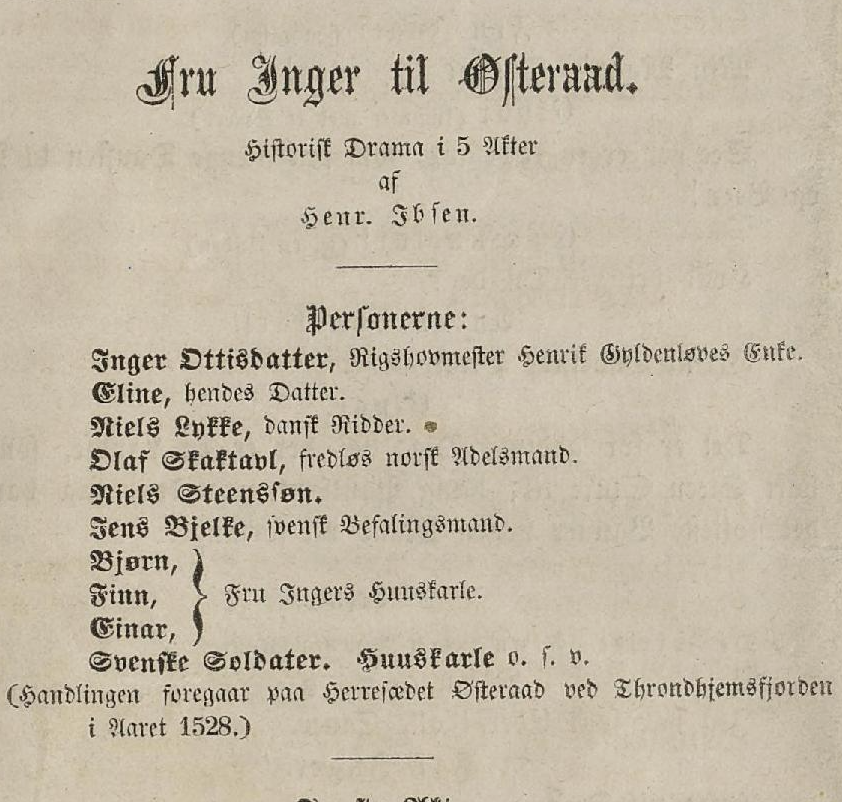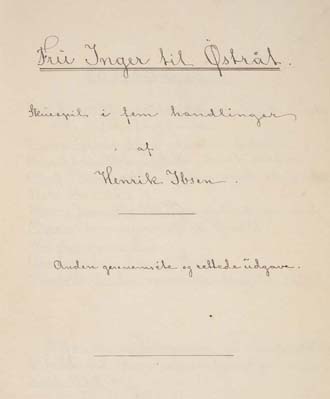

Brief description
It is not known exactly when Ibsen started working on Lady Inger. It was written during his period as director and dramatist at Det norske Theater in Bergen. Around 1 October 1854 he handed the completed script to Peter Blytt, chairman of the board of the theatre. In his book «Memories of the first Norwegian theatre in Bergen in the 1850s» Peter Blytt writes:
After some rather confused introductory words, he handed me the book, saying it was a manuscript sent him by a friend in Christiania, a historical drama or a tragedy if you like, which the author concerned, who wished to remain anonymous, would like to be performed on the Bergen stage, if it was considered worthy of acceptance. But before he handed it in to the board he – Ibsen – would like me to read it through and give him my opinion.
Ibsen's reason for not revealing himself as the author of the play is not difficult to guess. His own productions of St. John's Night in 1853 and The Burial Mound in 1854 were both flops, an his self-esteem was at a low level.
In working on Lady Inger Ibsen was forced to busy himself with historical sources. Among the historians at that time there was a certain interest in the Danish-Norwegian union. Two publications by Danish historians are thought to have played a special role in the coming into being of Ibsen's play: Caspar Paludan-Müller's work Grevens feide: skildret efter trykte og utrykte Kilder («The Count's Feud, from printed and unprinted sources»), published in two volumes in 1853/54, and volume one of Samlinger til det Norske Folks Sprog og Historie («Collections on the Language and History of the Norwegian People»), published in 1833. The former contains a description of Ingerd Ottisdatter's attempt to start a Norwegian rising in the cause of independence in 1527–28. The latter contains a collection of letter`s from 1525–29, collected and edited by Professor Gr. F. Lundh.
Ibsen's treatment of the historical material is very free, however. When he revised the play in 1874 for a new edition, he asked his friend the historian Ludvig Daae for his opinion of the use of historical sources in the original edition. Daae's conclusion was that the play was not in the least historical.
Peter Blytt was enthusiastic about the script Ibsen had given him, and the board of Det norske Theater agreed that the play was suitable for the projected gala performance on 2 January 1855, on the occasion of the theatre's fifth anniversary.
Just before the first night, Ibsen – involuntarily – revealed himself to be the author of the play. The anecdote relates that there was an incident during rehearsals when he rushed out of the wings, interrupted Jacob Prom, the actor playing Niels Lykke, in one of his longer speeches, and delivered it himself in the way he thought it should be delivered. This took place without Ibsen looking at the prompter's script, and in such a way that those present could have no doubt that he was the author. All the same, Ibsen insisted that his name should not appear on the poster or in the preliminary announcements.
Lady Inger was performed as planned at Det norske Theater on 2 January 1855, but this production was not a success either. The public showed less interest than expected, and the play was performed only twice.
Several years passed before Lady Inger was published. Around New Year 1856/57 Ibsen sent the manuscript to the publisher Chr. Tønsberg, who had published The Feast at Solhoug in March 1856, but was politely turned down. On 17 April 1857, he wrote to his friend Paul Botten-Hansen, editor of the literary weekly Illustreret Nyhedsblad, the following:
as it is imperative for me to have this, my best piece of work, published, I now ask you to take care of the matter and do what you can for me. Tønsberg has the play; read it through – and get me a publisher! I am not concerned about the conditions – I can willingly let the fee go as long as you can just get it printed. [read the letter in HISe]
Botten-Hansen suggested publishing the play as a serial in the Illustreret Nyhedsblad. Ibsen had no objection to this, and the play was printed in five numbers of the weekly in the period 31 May to 23 August 1857. In November the same year the owner of Illustreret Nyhedsblad, the printer H. J. Jensen, published an offprint of the play in a limited edition of probably only 250 copies.
In the spring and summer of 1874 Ibsen revised the play. Fru Inger til Østeraad became Fru Inger til Østråt. The publisher was now Frederik Hegel of Gyldendalske Boghandel in Copenhagen, and the edition consisted of 4000 copies. It was issued in November 1874.
(From ibsen.net)
Read Lady Inger (in Norwegian)
In the online version of the official Ibsen edition (HISe), you can read Lady Inger in various formats. This content is currently only available in Norwegian. Follow the links below to read the play:
Introduction to the work (in Norwegian)
The online version of the official Ibsen edition (HISe) offers extensive information about Lady Inger in Norwegian. Follow the links below to read about various aspects connected to the play.
About the modified version (1874)
In 1869, Ibsen attended a conference on proof-reading in Stockholm. Subsequently, he re-wrote all his previous dramas in accordance with the proof-reading norm agreed upon at the conference. He also made some changes to the content.
Read the modified version (in Norwegian)
In the online version of the official Ibsen edition (HISe), you can read Lady Inger (1874) in various formats. This content is currently only available in Norwegian. Follow the links below to read the play:
Introduction to the modified version (in Norwegian)
The online version of the official Ibsen edition (HISe) offers extensive information about Lady Inger (1874) in Norwegian. Follow the links below to read about various aspects connected to the play.
- Creative process
- About the publication
- Translations from Ibsen's life time
- Stagings in Ibsen's life time
- More information
Reviews
Here you can find reviews in full text and an overview of registered reviews in various languages.
- Reviews from Ibsen's life time in full text
- Reviews registered in the Ibsen bibliography (nb.no)
- Reviews registered in "Norsk litteraturkritikk" (UiO)